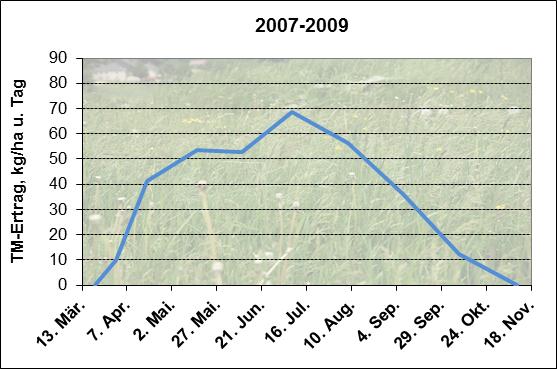A question that comes up again and again when it comes to permanent pastures relates to yields. Permanent pastures are usually assumed to have a low yield because the forage on the area is short and this results in a low yield.
Particularly in short-grass pastures, the stand has an average height of 6-7 cm when growth is optimal, which visually underlines the assumption of low yields. In order to determine the yield situation on short grass pastures in the Eastern Alpine climate region, pasture experiments were carried out at the Bio-Institute of the LFZ Raumberg-Gumpenstein to investigate this question.
Examination results:
As part of a research project, an area that had previously been used as a cutting meadow began to be used according to the short-grass pasture system. During 3 years of study (2007-2009) the yields of both systems (cutting and pasture) were compared. Before you can begin comparing the returns, a few points must be taken into account. So-called crop yields are determined in experiments. These are earnings gained with virtually no loss. After mowing with a motor mower, the harvested crop is collected and put into bags. The dry matter is determined immediately from the sample material. This is a situation that does not occur in practice.
The following sources of loss should be mentioned in a cutting system: respiration, crumbling, storage and manger losses. In an optimally managed pasture, many of the losses that occur when using cuttings do not occur. Ideally, no re-mowing is necessary here and then the losses on the pasture are only the horny areas that were not eaten in the autumn.
In the study, crop yields of 11,000 kg DM/ha were determined in the 3-cutting use and the short grass pasture was 2,000 kg DM/ha lower. In a further step, practical losses in both systems were assumed (cutting use 25% and short grass pasture 10% quantity losses). After deducting the losses, the amount of feed that can be used in both systems is arrived at. In this case, both systems no longer showed any difference. The yield of 8,000 kg DM/ha means that high forage yields are possible on the short grass pasture and can easily keep up with a cutting system.
In another research project, four different uses were compared. This involved a 4-cut use, short-grass pasture, hay pasture (1st cut and then short-grass pasture) and an annual alternation between 4-cut use and short-grass pasture. In this case too, the cutting use was 2,000 kg DM/ha higher than the crop yields of the short grass pasture at almost 12,000 kg DM/ha. The crop yields of hay pasture, short grass pasture and alternating cutting/grazing use did not differ from each other.
Figure 1: Yield comparison of cutting use and short grass pasture
Figure 2: Yield comparison of 4 different types of grassland use
The amount of grass growth during the growing season can be calculated from the yields collected from the short grass pasture. These quantities are crucial for how many animals can be kept per hectare. In the first 4 weeks of growth (beginning of April to beginning of May), the yield increased from 0 to 40 kg DM per ha and day. During this time, 2-3 cows can be kept on pasture day and night. The growth then increases around the time of the first cut and was able to achieve growth rates of up to 80 kg DM per ha and day. Such growth rates would provide fodder for 5-6 cows to graze day and night. The growth curves shown here for the individual years also illustrate the annual differences and show that the same number of animals cannot be kept on the area in the same period every year. Therefore, constant adjustment of the animal population and the area is necessary. Measuring the height of grass growth is particularly important here.






